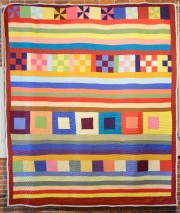Story by Britta Konau in The Free Press

Crazy Quilt by Lucy Mongo
The story of Gee’s Bend quilts is a complicated, sad and happy one. Gee’s Bend, a remote, historically African-American village on a peninsula formed by the Alabama River, originated in the early 1800s from slave cabins of Joseph Gee’s cotton plantations. Women slaves and their emancipated descendants made quilts from worn-out clothes, feed sacks, and whatever scraps might be usable to provide warmth in unheated housing. Poverty was rampant and interaction with neighboring towns limited (ferry service was suspended by the cross-river town in response to Benders’ civil rights protests). How the rest of the world found out about those quilts has been recounted many times. In 1997, William Arnett, an art collector and scholar, tracked down the women after having seen photographs of some of their quilts. He bought nearly 700 old quilts and contracted for intellectual property rights to all quilts made before 1984, which he transferred to his non-profit promoting vernacular art, Tinwood Alliance. In 2002, the nationally touring exhibition of 70 quilts from that collection, “The Quilts of Gee’s Bend,” took the art world by surprise and was followed by commodification of the quilts’ designs into home products (postal stamps, too, were issued).
Read the full story in The Free Press

